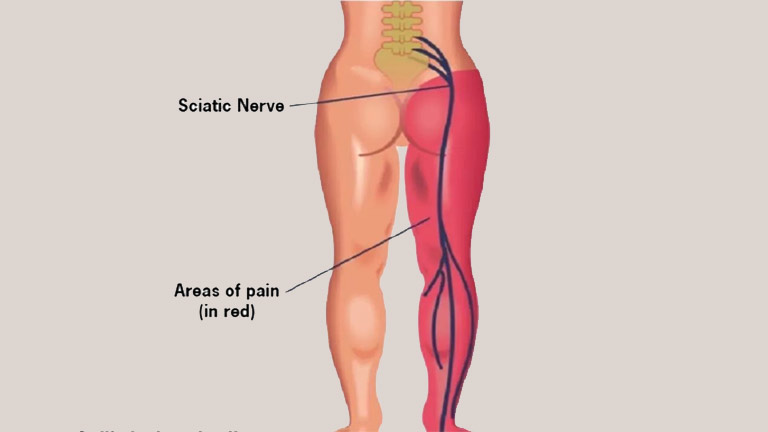
Sciatica is a term that many have heard, but few fully understand. Characterized by pain that radiates along the path of the sciatic nerve, which branches from your lower back through your hips and buttocks and down each leg, it can be a debilitating condition. But what exactly causes it, and more importantly, how can it be treated? Let’s delve into the world of sciatica and explore the various treatment options, including the role of experienced chiropractic care.
Sciatica, often mistaken as a singular medical ailment, is in reality a manifestation of an underlying issue related to the sciatic nerve. This nerve, the longest in the human body, originates in the lower spine, extending through the hips and buttocks, and travels down each leg. When this nerve is irritated or compressed, it results in the condition known as sciatica.
Root Causes of Sciatica
Lumbar Herniated Disc: Often referred to as a slipped or ruptured disc, this occurs when the soft inner material of the disc leaks out, irritating the nearby nerve roots. This is one of the most common causes of sciatica.
- Degenerative Disc Disease: As we age, our intervertebral discs can deteriorate or break down, leading to a loss of cushioning between the vertebrae. This can cause direct irritation of the nerve.
- Lumbar Spinal Stenosis: This condition is characterized by the narrowing of the spinal canal in the lower back, often compressing the nerves.
- Spondylolisthesis: Here, a vertebra slips forward over the one below it, which can compress the nerve and cause sciatica.
- Piriformis Syndrome: The piriformis muscle, located in the buttock region, can sometimes irritate or compress the sciatic nerve due to muscle spasms.
- Pelvic Injuries or Fractures: Any trauma to the pelvis can potentially harm the sciatic nerve, leading to inflammation and pain.
Recognizing the Symptoms
The hallmark of sciatica is pain, but the nature and intensity of this pain can vary widely among individuals. Some may experience a mild aching sensation, while others describe a sharp, burning, or even electric shock-like pain. This pain typically originates in the lower back or buttock and travels down the leg. Accompanying this pain can be symptoms like numbness, muscle weakness, tingling sensations, and difficulty in moving or controlling the leg.
The Anatomy Behind the Pain
Understanding the spine’s structure provides clarity on sciatica’s origins. The spine, a complex structure, comprises individual bones called vertebrae, cushioned by discs. These discs, made of a gel-like substance encased in a tough exterior, act as shock absorbers, preventing the vertebrae from grinding against each other. However, when a disc’s outer layer tears or weakens, the inner material can protrude, leading to what’s known as a herniated or bulging disc. This protrusion can press against the nearby sciatic nerve, causing inflammation, pain, and other sciatic symptoms.
In essence, while sciatica might seem like a singular issue, it’s a complex condition with various causes and manifestations. Recognizing its root cause is crucial for effective treatment and long-term relief.
Treatment Options
For many, sciatica can be a temporary discomfort, resolving on its own. However, for persistent pain, various treatments can be considered:
- Medications: Over-the-counter painkillers like ibuprofen can be effective. In more severe cases, other medications might be prescribed.
- Physical Therapy: Once the pain subsides, physical therapy can help prevent future flare-ups. This includes exercises to correct posture, strengthen the core, and improve flexibility.
- Surgery: In cases where the pain is due to a herniated disk or other spinal issues and doesn’t improve with other treatments, surgery might be an option.
- Alternative Therapies: Some people find relief through alternative therapies like acupuncture and chiropractic adjustments. Especially, experienced chiropractic care can be beneficial. Chiropractors can make spinal adjustments to restore spinal movement, decreasing pain. This method appears to be as safe as standard treatments for low back pain.
Prevention and Lifestyle Changes
Prevention is always better than cure. Regular exercise, ensuring proper posture when standing or sitting, and lifting objects correctly can help reduce the risk of developing sciatica. For those with a sedentary lifestyle, taking breaks and walking around can also be beneficial.
Conclusion
Sciatica can be a painful and debilitating condition, but understanding its causes and treatment options can help sufferers find relief. While there are various treatments available, experienced chiropractic care stands out as a non-invasive and effective method to address the root cause of the pain. As with any medical condition, it’s essential to consult with healthcare professionals to determine the best course of action.




